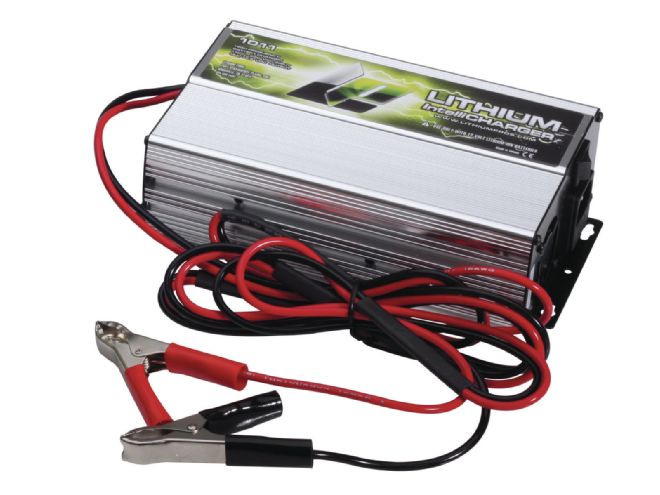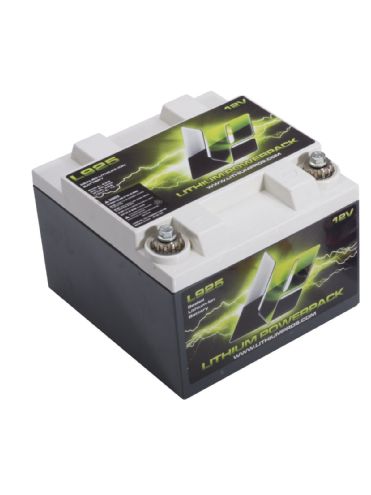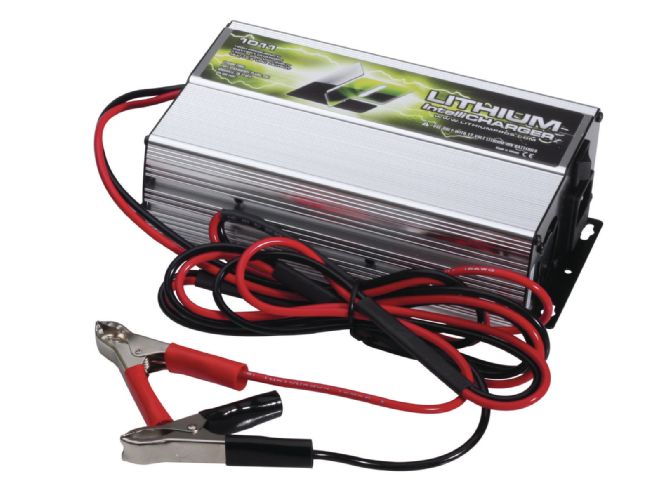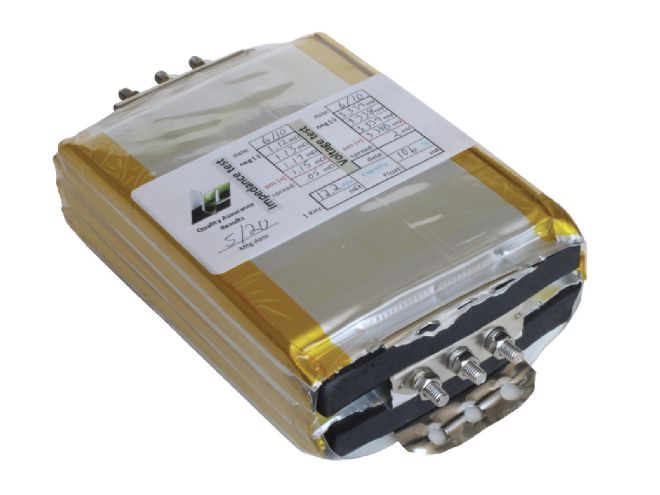
The Premise
Putting your hot rod on a diet is an easy way to increase its performance (“Caddy Hack” in Feb. ’87 and “Vette Hack” in Nov. ’10 proved it). But once you’ve removed every ounce of excess sheetmetal in your car, lightened the engine with aluminum pieces, and gutted the interior, what’s left? How about shedding 30 pounds or more from the engine compartment or trunk with a super-lightweight battery? The Lithium Pros brochure describes the company’s lithium-ion batteries as God’s gift to electrical systems: safe, powerful, ultralight, and with a shorter recharge time than a standard lead-acid or dry-cell battery. It sounds like the perfect battery, so of course we must test it. With a price tag of more than $1,395 for the battery and a dedicated charger, it’s a product aimed at racers and weight-conscious heavy hitters in the street car world—you know, the ones who have hot rods with a lot of onboard electronics to power.
 Lithium Pros says it expects its batteries to last up to 10 years if not discharged beyond 50 percent. The one gripe we have about the product is that you cannot jump-start it because that will damage the cells. But we love the low 91⁄2-pound weight.
Lithium Pros says it expects its batteries to last up to 10 years if not discharged beyond 50 percent. The one gripe we have about the product is that you cannot jump-start it because that will damage the cells. But we love the low 91⁄2-pound weight.
The weight difference between Lithium Pros batteries and lead-acid batteries is staggering, and the company offers units to fit everything from a Harley to a Funny Car. High-power, flat-panel, prismatic lithium cells reduce the weight of the unit considerably. In short, a lithium-ion cell will store 150 watt-hours of power per kilogram, while a lead-acid cell will only store 25 watt-hours per kilo. Nickel metal hydride batteries fall somewhere in between. It’s similar to the technology used in cell phones and laptops, but on a larger scale. The rub is that the supply of these particular cells is limited and the demand is not yet there, which makes them three to five times more expensive than other battery designs.
The Stuff
Lithium Pros offers three different types of lithium-ion batteries: the L-Series, the T-Series, and the C-Series. The L-Series features an internal battery management system (BMS), a MOSFET computer inside the case that controls the current entering and exiting the battery. The BMS protects the cells from short-circuit, over-current, low-voltage, over-voltage, and over-temperature problems that can occur when the battery is improperly charged or connected incorrectly to a hot rod. The L-Series carries a full two-year warranty and is available for 12- or 16-volt systems. The T-Series has the same MOSFET protection during charging but not during discharging, and it’s built for drag or circle track racing, where harsh vibrations are present and when an alternator is not an option for maintaining the battery. The most affordable option in Lithium Pros’ lineup is the C-Series, which has the same power output but doesn’t have the BMS to protect the cells. The T- and C-Series carry a two-year prorated warranty. Worried about spending a small fortune to try one of these bad boys? Every battery has a 60-day, money-back guarantee.
 Left: In a pinch, a low-amperage charger designed for AGM batteries can be used, although we don’t recommend it. The Lithium Pros charger is fully automatic and will ensure the battery doesn’t overheat while charging; the nifty status display keeps tabs on the progress.
Left: In a pinch, a low-amperage charger designed for AGM batteries can be used, although we don’t recommend it. The Lithium Pros charger is fully automatic and will ensure the battery doesn’t overheat while charging; the nifty status display keeps tabs on the progress.
We used the top-end L-series battery for our test.
The Test
Although Lithium Pros offers batteries with the same footprint as a standard Group 24 lead-acid unit, we chose an L925-size battery because it’s a direct replacement for the Odyssey PC-925 dry-cell ($180) we’d been using. The Odyssey is a favorite among racers because it’s small, can be mounted in any orientation, and is about 15 pounds lighter than a comparable lead-acid unit. The Lithium Pros L925 is dimensionally identical, so we were able to literally replace the 28-pound dry-cell battery with a 91⁄2-pound lithium part. Sealed construction means it can also be mounted any way you like. The reserve capacity of the Odyssey is rated at 50 minutes, and the L925 is rated at 53 minutes. Both have a 925-amp rating when hot cranking for five seconds. This all sounds fine on paper, but how does it work at the racetrack?
Our test mule is the 582ci, all-aluminum big-block Chevy we built in the Nov. ’10 issue (“1,164 HP Without a Power-Adder”). Retarding the ignition timing 10 degrees during cranking, using a gear-reduction starter motor, and employing a good battery are all keys to starting this 14.5:1- compression beast. A 55-amp East Coast Auto Electric alternator barely keeps up with the demands of the Nitrous Supply direct-port nitrous system solenoids (which draw 44 amps), the Magnafuel Prostar 500 fuel pump (which pulls 14 more amps), and the MSD Digital Programmable Digital 7 ignition box (which requires 1.1 amps per 1,000 rpm, 8.8 amps at WOT). We relied on an Edelbrock Qwikdata data acquisition system (2 more amps) to monitor the engine and battery performance throughout testing. With a total amp draw of 68.8 amps when running, it’s a serious drain on the charging system during quarter-mile passes.
The Results
We pulled the L925 out of the box, connected it to the big Chevy without hooking up the charger, and the engine fired right up like it always does, settling into a cackling idle. The Qwikdata box showed 13.2 volts at idle, just under 14 volts with every blip of the throttle. So far, so good. Next, we made a pass down the racetrack without the nitrous. No drama there, just steady voltage and predictable performance. Back in the pits we connected the charger, and the digital readout showed the battery was at 13.2 volts, and a fully-charged status was achieved in just under a minute. Then we made a pass with the nitrous system engaged. When the solenoids kicked on, the battery voltage dropped from 13.8 to 13.1 volts and then jumped back up once the pass was over. The battery charger was hooked up again, per our usual routine in the pits, and the L925 was fully charged again in exactly one minute. In previous testing, the Odyssey battery voltage would drop from 13.4 volts to 12.2 volts when the nitrous was activated, and after the pass it would take eight minutes to recharge. Then we made back-to-back nitrous passes, sapping as much current from the battery as possible without using the charger between runs to maintain the battery. The data during the first pass revealed 13.2 volts with the nitrous on. Pass No. 2 was 13.2 volts again; pass No. 3 was 13.1 volts. We made seven passes in a row without charging the battery, and the engine never hiccupped. Afterward, we left the ignition box on for eight hours, and the battery still had enough juice to fire the engine.
 Above: Lithium Pros batteries are so light that you’ll think the case is empty when you pick one up. These lithium-ion cells are smaller, store more power, charge at a faster rate, and weigh considerably less than their lead-acid cousins.
Above: Lithium Pros batteries are so light that you’ll think the case is empty when you pick one up. These lithium-ion cells are smaller, store more power, charge at a faster rate, and weigh considerably less than their lead-acid cousins.
In comparison, our old Odyssey battery could only go three laps without a recharge before failing to start the engine.
Conclusion
It’s a $1,400 battery and charger that weighs almost nothing, comes with a performance guarantee, and works as advertised. In a world where you don’t always get what you pay for, this is one case where the more expensive part lived up to the hype. Is it for everyone? Of course not. Unless you have the disposable income and are looking to shed every last ounce of weight from your car, there are other areas that can be improved for less money. The less expensive C- and T-Series batteries will save you a few hundred bucks, but they do not include the BMS and don’t have as comprehensive a warranty as the L-Series battery. Keep that in mind if you are prone to hooking battery cables up backward. For ultimate peace of mind, spring for the L-Series battery.